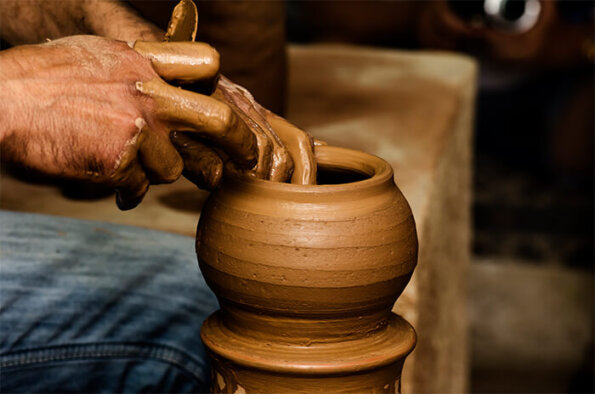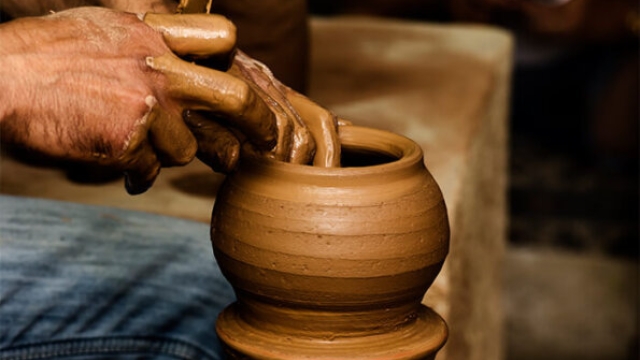
Pottery has been a cherished form of artistic expression for centuries, transforming simple clay into functional and beautiful works of art. From the humble beginnings of hand-formed vessels to the intricate designs of modern ceramics, the journey of pottery is a testament to human creativity and craftsmanship. Each piece tells a story, reflecting the culture and history of its time, and inviting us to appreciate the skill and passion of the artisans behind them.
Among the many talented creators in this field, Amitābha Studio stands out for its dedication to the craft. Specializing in unique, one-of-a-kind lamps, this studio breathes new life into antique and vintage Delft as well as other exquisite Dutch and Belgian pottery. By combining traditional techniques with innovative designs, Amitābha Studio not only honors the legacy of these timeless materials but also illuminates our spaces with a warmth and charm that only handmade pottery can provide.
The History of Delft Pottery
Delft pottery, renowned for its striking blue and white designs, has a rich history that dates back to the 16th century in the Netherlands. The craft began when Dutch artisans were inspired by the intricate ceramics imported from China. As the popularity of these Eastern ceramics grew, local potters sought to replicate their beauty while creating a unique Dutch identity in the art of pottery. This led to the establishment of pottery workshops in Delft, where skilled craftsmen experimented with glazing techniques and innovative designs.
By the 17th century, Delft pottery gained immense popularity, particularly during the Dutch Golden Age. The artisans of Delft created a wide variety of pieces such as plates, tiles, and vases adorned with elaborate paintings and scenes. The demand for these ceramics soared among the affluent classes, and the city of Delft became a significant center for pottery production. The distinct cobalt blue pigment used in the glazes became a hallmark of Delft pottery, setting it apart from other ceramic styles of the time.
In addition to its beauty, Delft pottery represents a blend of cultural influences, integrating Dutch themes with Chinese motifs. The intricate designs often depicted landscapes, floral arrangements, and historical scenes that reflected the society of the time. Over the years, the techniques and styles evolved, yet the timeless appeal of Delft pottery continued, making it a sought-after collectible and an essential part of Dutch heritage. Today, it is celebrated not only for its craftsmanship but for its contribution to the lasting legacy of pottery artistry.
Crafting Unique Lamps
Delft Blue
Amitābha Studio stands out in the world of pottery by transforming antique and vintage Delft and other Dutch and Belgian pieces into stunning lamps. Each lamp reflects a careful selection process where the history and artistry of the original pottery are preserved while also being reimagined for modern spaces. This balance between the old and new creates a unique aesthetic that appeals to those who appreciate handcrafted art.
The craftsmanship involved in creating these lamps goes beyond mere functionality. Each piece is meticulously assembled, with great attention paid to the intricacies of the pottery. The studio takes pride in highlighting the original designs, colors, and textures of the vintage materials, ensuring that every lamp tells a story of its own. This dedication to artistry results in one-of-a-kind lamps that serve as both light sources and conversation pieces in any room.
In a world filled with mass-produced items, Amitābha Studio’s lamps are a breath of fresh air. They offer collectors and interior designers a way to incorporate distinctive character and history into their decor. By merging the traditional craftsmanship of pottery with contemporary design elements, these lamps become not just functional objects but also cherished works of art, illuminating both spaces and imaginations.
Sourcing Antique Pottery
Finding genuine antique pottery requires a keen eye and an appreciation for history. At Amitābha Studio, the process begins with careful research into various sources that may offer genuine pieces. Antique shops, estate sales, and auctions are prime locations where unique items can be discovered. Each piece carries its own story, adding rich character to the final creations. Collaborating with trusted dealers and experts also enhances the chances of sourcing pottery that is both authentic and of high quality.
Traveling to regions known for their pottery traditions is another crucial strategy. The rich heritage of Delft and other Dutch and Belgian pottery comes with distinctive styles and techniques that demand close examination. Visiting local markets and specialist shops allows the team at Amitābha Studio to connect with artisans and gather pieces that reflect the intricate craftsmanship of the past. These direct interactions further enrich the sourcing process, as they open avenues for collaboration and negotiation.
Preserving the integrity of antique pottery is paramount. Each item is handled with great care, ensuring that its unique features and historical significance remain intact. Amitābha Studio is committed to sustainability and ethical sourcing, prioritizing pieces that resonate with their values. The careful curation of these antique finds not only supports the preservation of traditional art forms but also allows for the creation of unique lamps that illuminate spaces with a touch of history and artistry.
The Artistic Process
Crafting pottery is an intricate and expressive journey that begins with the careful selection of clay. Different types of clay provide unique textures and colors, allowing artists to convey their visions clearly. For Amitābha Studio, this initial choice reflects a commitment to quality, as they seek out the finest materials to create their remarkable lamps. The manipulation of clay requires not only skill but also an intuitive understanding of how the material responds to pressure and form.
Once the clay is prepared, the process shifts to shaping the pieces. Using a potter’s wheel, slabs, or hand-building techniques, each lamp takes on its own identity. This stage is where creativity flourishes, as artists must balance functionality with artistic expression. The integration of antique and vintage Delft pottery adds a historical richness and narrative depth to each creation. The unique patterns and glazes of these materials transform ordinary lamps into storytelling pieces of art.
After shaping comes the critical phase of firing and glazing. This step solidifies the clay and enhances its aesthetic appeal. Artists at Amitābha Studio carefully choose glazes that complement the distinctive characteristics of the Dutch and Belgian pottery they incorporate. Each firing reveals surprises, as colors can change and develop in unexpected ways, adding to the allure of the final product. The result is a stunning blend of traditional craftsmanship and contemporary design, creating lamps that are not just functional but also captivating works of art.
Sustainability in Pottery
Sustainability in pottery has gained significant attention as artisans and consumers alike increasingly value eco-friendly practices. The pottery industry is inherently connected to the earth, utilizing natural materials such as clay, glazes, and pigments. With a focus on sustainable sourcing, artisans can minimize their environmental impact by using locally sourced clays and avoiding harmful chemicals. This not only preserves the planet’s resources but also supports local economies and traditions.
Amitābha Studio exemplifies sustainable practices by specializing in the creation of unique lamps made from antique and vintage Delft and other Dutch and Belgian pottery. By repurposing these historical pieces, the studio not only reduces waste but also celebrates the craftsmanship of the past. This approach resonates deeply with consumers who appreciate the stories behind each lamp, offering a connection to history while promoting sustainable living.
Additionally, the emphasis on durability in pottery design enhances sustainability. Well-crafted pottery is built to last, reducing the likelihood of disposable items ending up in landfills. As consumers increasingly seek out products that reflect their values, pottery that prioritizes sustainability can help foster a greater appreciation for both the artistry involved and the environmental consideration behind each creation. This shift toward sustainable pottery not only benefits the environment but also enriches the cultural narrative of artisans and their crafts.


